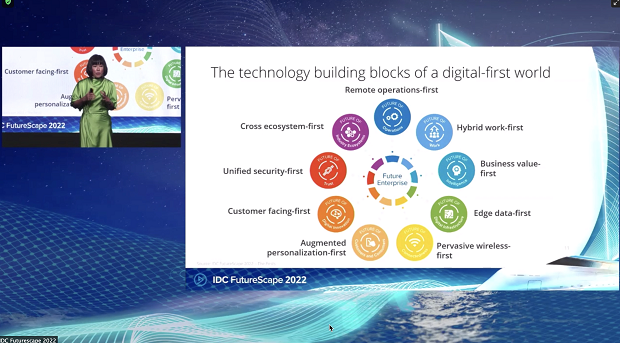Analyst firm IDC has revealed its top ICT predictions for 2022 and beyond to help Asia-Pacific businesses succeed in the digital-first world.

“Digital-first enterprises are future enterprises, and a digital-first world is the era of future enterprises.” said Sandra Ng, group vice president for ICT Practice IDC Asia-Pacific, during the company’s annual predictions event, IDC FutureScapes.
Each year, IDC releases its Top Predictions through its IDC FutureScape reports. These predictions have been used to shape the strategies and business objectives of technology leaders and business executives.
Ng explained that a digital-first economy is one where products, services, and experiences have gone digital and technology is harnessed to drive new competitive advantages.
“We know we are truly in a digital-first world when futuristic use cases have been brought forward because of the increased commercialization and increased demand in the market place,” asserted Ng.
Another concrete sign of a digital economy is that at least 65% of GDP comes from digital sources. According to IDC research, the accelerated digital transformation caused by the pandemic is especially pronounced in Asia Pacific, and the region will have at least 65% of its GDP represented by digital sources by the end of 2022.
Furthermore, IDC anticipates that spending on digital transformation will grow twice as fast compared to other ICT spending.
To make the most of their investments, Ng advised Asia Pacific organizations to be aware of the societal, macroeconomic, microeconomic, and technology trends that will affect their operations in the next few years.
The following ICT and business predictions identified by IDC will shape how Asia Pacific organizations and industries operate in the emerging digital economy:
- Digital rules: By 2023, 1 in 3 companies will generate more than 30% of their revenues from digital products and services, as compared to 1 in 5 in 2020.
- Diversity matters: By 2024, 55% of successful digitally innovative products will be built by teams that include people with creative, critical thinking, analysis, and automation skills as well as software engineers.
- The value in trust: By 2023, 40% organizations will allocate half of their security budget to cross-technology ecosystems/platforms designed for rapid consumption and unified security capabilities to drive agile innovation.
- The value in ecosystems: By 2026, on average 30% of Asia Pacific company revenue is derived from industry ecosystem shared data, applications, & operations initiatives with partners, industry entities, and business networks.
- Scaling with digital twins: From 2021 to 2027, the number of new physical assets and processes that are modeled as digital twins will increase from 5% to 60% resulting in operational performance optimization.
- Scaling with knowledge: 30% of large enterprises will see 25% improvement in information usage by 2026 due to investments in intelligent knowledge networks that turn structured/unstructured data into findable and actionable knowledge.
- An evidence-based culture is paramount for digital-first enterprises: By 2026, 30% of organizations will use forms of behavioral economics and AI/ML-driven insights to nudge employees’ actions leading to a 60% increase in desired outcomes.
- Digital infrastructure is at the core of future enterprises: By 2025, a 6X explosion in high dependency workloads leads to 65% of Asia Pacific firms using consistent architectural governance frameworks to ensure compliance reporting and audit of their infrastructure.
- Business value of networks: By 2022, more than 50% of organizations will prioritize connectivity resiliency to ensure business continuity, resulting in uninterrupted digital engagement to customer, employees and partners.
- Business value of IT: By 2024, digital-first enterprises enable empathetic customer experiences and resilient operating models by shifting 60% of all tech and services spending to as-a-service and outcomes-centric models.
As her talk wrapped up, Ng also warned businesses about the impact of technology department or the resource drain that occurs as a result of lack of integration among multiple systems. She stated that by 2025, 75% of CIOs and CFOs will be forced to accelerate or enact formal technology debt management prices due to project delays or failures caused by unresolved technology debt.
“Economic and business outlook for the next 3 years remains highly fluid because of a growing range of global challenges including the pandemic,” declared Ng. “An enterprise’s success in the next 12-36 months will be defined by how well it navigates these crosswinds.”




